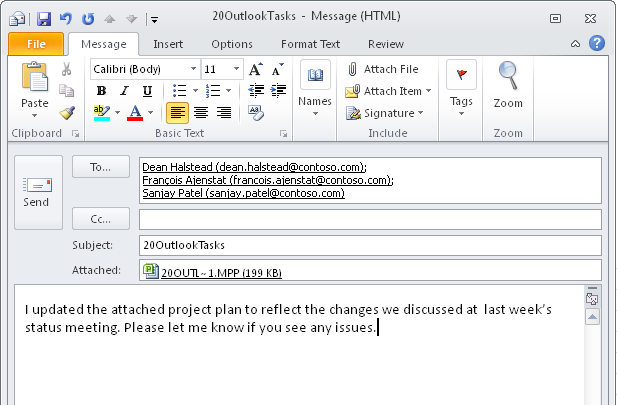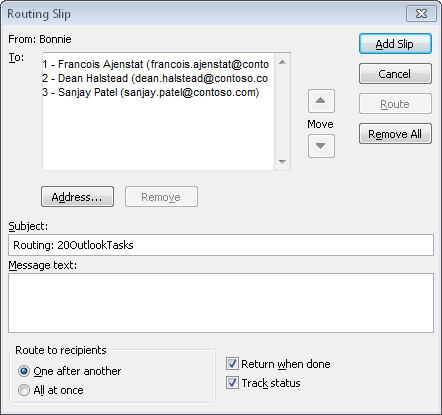You can send information from your project file to people who have Outlook or any other MAPI-based e-mail system, including Microsoft Exchange, Microsoft Mail, Novell Group-Wise, or Lotus Notes. You can send project file information in the following ways:
Send the entire project file as an attachment.
Send a selected set of tasks or resources as a Project 2010 file attachment.
Send a set of tasks or resources as a picture to a set of predefined recipients.
Route a project file to a group of recipients to obtain their input.
Publish a project file to a Microsoft Exchange public folder.
You can quickly send an entire file to selected recipients directly from your project file. To do this, follow these steps:
In Project 2010, open the project file you want to send.
On the File tab, click Save & Send, and then click Send As Attachment.
Your MAPI e-mail application is launched, if necessary. A new e-mail message form appears, with your project file attached and the name of the project in the Subject field.
In the To box (and Cc box, if necessary), add the e-mail addresses of the recipients.
In the message area, add any necessary comments regarding the project file.
The e-mail message should look similar to the example in Figure 20-6.
Click the Send button.
Your message and the attached project file are sent to the specified recipients.
Note
You can route a project file if you’re using Outlook or any other 32-bit MAPI-based e-mail program.
Sometimes you need to send project information to several individuals. Maybe you need feedback from each of your team leads about the task list and resource assignments for your project. Or, perhaps one team member is developing the task list, someone else is adding the resources, and someone else is assigning those resources to tasks. One way to share your work with several people is to route your project plan through e-mail to a list of individuals. You can specify whether your addressees receive your e-mail message one by one or at the same time.
Note
The Routing Recipient command is not available on the Project 2010 ribbon by default. However, you can add it to the Quick Access Toolbar or to a custom group on the ribbon. To add the command to the Quick Access Toolbar, click the arrow next to the toolbar and then click More Commands. In the Choose Commands From list, click Commands Not In The Ribbon, click Send To Routing Recipient, click Add, and then click OK.
Note
For information for how to add the Routing Recipient command to a custom group in the ribbon, see Customizing the Project 2010 Ribbon.
To route a project file, follow these steps:
In Project 2010, open the project file you want to route.
On the customized Quick Access Toolbar, click Send To Routing Recipient. If a security alert appears, click Allow.
The Routing Slip dialog box appears.
Click the Address button.
The Address Book dialog box appears.
Click the names of the individuals you want on the distribution list, and then click the To button. Click OK.
Note that to open the project file, each individual on the distribution list must have access to Project 2010 on their computer.
If you’re routing the project to one recipient at a time, use the Move buttons to designate the order of the recipients.
In the Subject field, change the subject if necessary.
In the Message Text box, enter any comments or instructions to accompany the attached project file. (See Figure 20-7.)
Under Route To Recipients, select the One After Another option (the default) or the All At Once option.
Although sequential routing can be time-consuming and impractical for urgent information, it can work well for review and evaluation, especially when reviewers are in widely dispersed locations. Each recipient edits the project file and adds comments to the routing message. To send it to the next designated addressee, the recipient clicks File, Send To, Next Routing Recipient.
Select the Track Status check box to keep an eye on the progress of the project routing and make sure it doesn’t get stuck too long with any one recipient. Select the Return When Done check box to make sure the file comes back to you so that you can see everyone’s changes and comments.
Click the Route button.
The message with the project file is routed to your designated recipients through e-mail.
The routing e-mail has the project file attached (see Figure 20-8), although the instructions it provides for the recipients aren’t accurate. When a recipient finishes reviewing the project, he or she uses the Send To Routing Recipient command as described in the steps above. The person can add comments to the message and click Route to send an e-mail with the file attached to the next routing recipient. When the last recipient has reviewed the project, the originator of the routing message receives an e-mail message with the attached project and any comments added by previous recipients.
Note
You can publish a project file to an Exchange folder if you’re using Microsoft Exchange Server and if you have permission to use public folders.
You can send your project file to an Exchange folder, which is especially useful for making the project file available to a large number of stakeholders. The Send To Exchange Folder command is not available on the Project ribbon by default, but you can add it to the Quick Access Toolbar or to a custom group on the ribbon.
Note
For information on how to add a command to the ribbon, see Customizing the Project 2010 Ribbon.
To send the file to an Exchange folder, do the following:
In Project 2010, open the project file you want to publish to an Exchange folder.
On the Quick Access Toolbar or the custom group on the ribbon, click Send To Exchange Folder.
The Send To Exchange Folder dialog box appears, displaying the folders available to you.
Click the folder to which you want to send the project file, and then click OK.
Your project file is copied to the selected folder.



